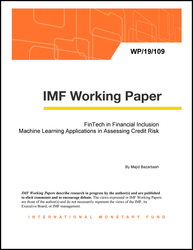
FinTech in Financial Inclusion: Machine Learning Applications in Assessing Credit Risk
Recent advances in digital technology and big data have allowed FinTech (financial technology) lending to emerge as a potentially promising solution to reduce the cost of credit and increase financial inclusion. However, machine learning (ML) methods that lie at the heart of FinTech credit have remained largely a black box for the nontechnical audience. This paper contributes to the literature by discussing potential strengths and weaknesses of ML-based credit assessment through (1) presenting core ideas and the most common techniques in ML for the nontechnical audience; and (2) discussing the fundamental challenges in credit risk analysis. FinTech credit has the potential to enhance financial inclusion and outperform traditional credit scoring by (1) leveraging nontraditional data sources to improve the assessment of the borrower’s track record; (2) appraising collateral value; (3) forecasting income prospects; and (4) predicting changes in general conditions. However, because of the central role of data in ML-based analysis, data relevance should be ensured, especially in situations when a deep structural change occurs, when borrowers could counterfeit certain indicators, and when agency problems arising from information asymmetry could not be resolved. To avoid digital financial exclusion and redlining, variables that trigger discrimination should not be used to assess credit rating.
Publication date: May 2019
ISBN: 9781498314428
$18.00
Add to Cart by clicking price of the language and format you'd like to purchase
Available Languages and Formats
| English |
Prices in red indicate formats that are not yet available but are forthcoming.
Topics covered in this book
This title contains information about the following subjects.
Click on a subject if you would like to see other titles with the same subjects.
FinTech Credit , Financial Inclusion , Machine Learning , Credit Risk Assessment , outcome variable , borrower , LGD , decision tree , cross-validation
Also of interest
Summary
Copyright © 2010 - 2025
Powered by:
AIDC



